|
In the mid '30s, most of the airplanes of the ARR were obsolete.
So, in November 1936, IAR proposed to the Ministry
of the Air and Navy a new project. It was a modern all metal, low wing
monoplane fighter and was named IAR-80. The designers were prof. Ion Grosu and
Ion Cosereanu, eng. Gheorhe Zotta, Viziru Grosu and Ion Wallner.
The airplane was going to be fitted with the Junkers Jumo 211Da. The
contract was signed, but the Germans failed to deliver the 3 engines they
promised in 1937. The IAR-14K engine was the only one available and the
prototype was equipped with it. It weighted less with about 200 kg, but it
was an "oil drinking" machine and had a lower power output.
The engines didn't arrive even in 1939, so it was decided that the
first production batch (1-20) be fitted with the IAR-14K engine.
The prototype flew for the first time on 12 April 1939. The test pilot
was cpt. av. Dumitru Popescu. It was presented to the public at the air
show on 20 July and by the end of the year it had finished all the tests.
A first order of 50 airplanes was given by the Ministry of the Air and
Navy.
The IAR-80 was one of the best fighters in the world in 1939. Here is the
report of the Luftwaffe major that tested it in March 1941:
"Take off and landing are very good. It's 20-30 km/h slower than the Bf-109E.
The climb to 5,000 meters is equivalent. In a dogfight, the turns are also
equivalent, although the long nose reduces the visibility. In a dive it's outclassed
by the Bf-109E, because it lacks an automated propeller pitch regulator. It's a fighter
adequate to modern needs."
In February 1941, the first IAR-80s were delivered to the newly formed 8th Fighter
Group. This unit was engaged in the fighting from the very first day of Barbarossa.
The airplane performed very well against the modest Soviet airplanes, especially
against the I-16 Rata. The first victory achieved by an IAR-80 came on 27 June.
The first IAR-80 shot down was no. 23 of slt. Vasile Claru (KIA) on 12 July.
On 15, the 52nd Squadron passed its remaining He-112Bs to the 51st Squadron and formed
with the 42nd the 42/52nd Fighter Squadron, which received new IAR-80s. On 27 September,
the 6th Fighter group gave up its P.24Es to the 4th Fighter Group and began training
for the IAR-80. The first 6 IAR-81s came to the front to the 59th Squadron (8th Fighter
Group). The first dive bombing mission was on 15 October, when 5 airplanes bombed Odessa
harbor. During the first campaign 21 IAR-80s and As were lost. Over 100 VVS airplanes
were claimed in the air and on the ground by IAR-80 pilots.
In January, the 6th Fighter Group started to convert to the IAR-81 dive bomber.
In April, the 9th Fighter Group was created. It was also going to receive the
IAR-80A. The 8th Fighter Group was assigned to home defense. Its first real mission
was on 12 June, when the USAAF carried out its first raid in Europe, at Ploesti. The
gropup claimed one victory, which wasn't confirmed however. In July, the 4th Fighter Group
began training with the IAR-80A and in August it was the 3rd Fighter Group's turn.
The airplane was still comparable with the Soviet fighters, but had inferior weapons
and armour. In September the 6th and 8th Fighter Groups were sent to the front at
Stalingrad. They claimed 45 VVS airplanes shot down, while losing 11 airplanes in dogfights
or to enemy AAA, 3 destroyed on the ground, 9 in accidents and 6 captured by the advancing
Red Army forces. The two groups started their return home on 23 December.
In 1943 the IAR-80 was given the role of home defense. The 4th Fighter Group received
new IAR-80Cs and transferred its IAR-80As to the 3rd Fighter Group. It had two squadrons
(46th and 49th) on the Black Sea coast at Cetatea Alba and another (45th) at Targsor, near
Ploesti. The 6th Fighter Group was stationed on the Pipera airfield near Bucharest. In
April, the 9th Fighter Group abandoned its IAR-80As for the Bf-109Gs and the 8th Fighter
Group was transformed into the 8th Assault Group (Hs-129BS). On 1 August 1943, took place
the second USAAF raid over Ploesti: Operation Tidalwave. The 6th Fighter Group and the 45th
Fighter Squadron had 7 confirmed and another 2 probable B-24Ds shot down, while losing one
IAR-80B and having another two damaged. In October, the 7th Fighter Group came back
from the front and received IAR-81Cs. Also the 1st Fighter Group, stationed on the Rosiorii
de Vede airfield received IAR-80Cs. The 4th Fighter Group scored 7 confirmed and one
probable kill in their convoy escort missions during 1943.
In January 1944 some of the active IAR80s, 80As and 80Bs were rearmed 20 mm cannons,
thus being transformed into IAR-80Cs. The 2nd Fighter Group (IAR-80C) was located on the
Ianca airfield. The 51st Squadron of the 5th Fighter Group was also equipped with IAR-81Cs.
In home defense there were also the 1st, 4th, 6th and 7th Fighter Groups. On 1 April 1944
there were 302 IAr-80s on duty, out of which 227 were available. The 15th Air Force started
its raids over Romania on 4 April. During the following air battles with the USAAF they
fought bravely and shot down about 80 Liberators. Because of its weak engine the IAR-80 was
an easy prey for the escort Mustangs at the high altitudes the dogfights were carried out.
On 10 June 1944 the IAR-81C was very successful against the low-flying Lightings. It was
its last glory day. All were grounded in August 1944, after suffering very heavy losses. 36
IAR-80 pilots died in those 4 months of hell. The 2nd Fighter Group was also engaged in the
fighting against the Soviets on the front in Moldavia and it claimed a few victories.
In the events following 23 August 1944, some IAR-80s were used to attack retreating
German columns, strongholds or transport airplanes bringing reinforcements. After things
settled down a bit, in September, the 2nd and 4th Fighter Groups were united into the
2nd, which was used in the fights in Transylvania. It was soon joined by the 6th Fighter
Group. They suffered heavy casualties against the modern German fighters and AAA, while
claiming only a few kills. On 30 September the production of the IAR-80 ceased. The
airplane was relegated to ground attack role. In December, the 6th Fighter Group returned
home, in order to start training with the Bf-109G. The 2nd Fighter Group remained on the
front until the end of the war. The last mission of an IAR-80 was flown on 8 May 1945.
During the entire war, the IAR-80 (in all its variants) scored 539 confirmed kills,
90 probable and 168 on the ground. About 220 were lost in combat (to fighters and AAA) and
in numerous accidents.
The Prototype
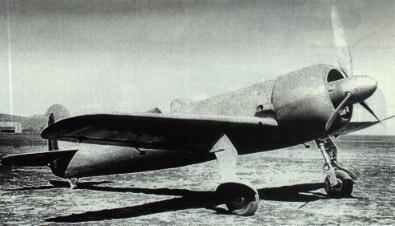
Picture from "Vanatorul IAR-80, istoria unui erou necunoscut" by
Dan Antoniu & George Cicos, MODELISM, 2000
| Wingspan |
10 m |
| Length |
8.16 m |
| Height |
3.6 m |
| Weight (empty) |
1780 kg |
| Weight (loaded) |
2270 kg |
| Maximum speed at 5000 m |
510 km/h |
| Climbs to 5000 m |
6 min. |
| Maximum operational ceiling |
11000 m |
| Range |
700 km |
| Engine |
IAR 14K IIc32 870 HP |
| Machine-guns |
2x7.92 mm |
| Serial number |
0 |
The IAR-80
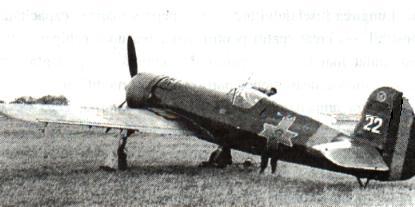
Picture from "Vanatorul IAR-80, istoria unui erou necunoscut" by
Dan Antoniu & George Cicos, MODELISM, 2000
| Wingspan |
10.52 m |
| Length |
8.9 m |
| Height |
3.6 m |
| Weight (empty) |
2045 kg |
| Weight (loaded) |
2483 kg |
| Maximum speed at 5000 m |
485 km/h |
| Climbs to 5000 m |
5 min. 27 sec. |
| Maximum operational ceiling |
10500 m |
| Range |
760 km |
| Engine |
IAR 14K IVc32 1000A 1000 HP |
| Machine-guns |
4x7.92 mm |
| Serial numbers |
1-50 |
The IAR-80A
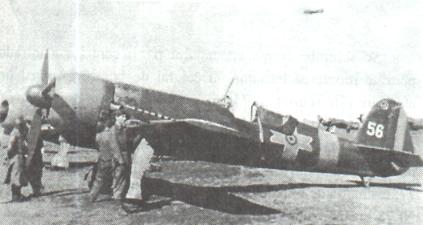
Picture from "Vanatorul IAR-80, istoria unui erou necunoscut" by
Dan Antoniu & George Cicos, MODELISM, 2000
| Wingspan |
10.52 m |
| Length |
8.97 m |
| Height |
3.525 m |
| Weight (empty) |
2110 kg |
| Weight (loaded) |
2720 kg |
| Maximum speed at 5000 m |
485 km/h |
| Climbs to 5000 m |
5 min. 50 sec. |
| Maximum operational ceiling |
10500 m |
| Range |
730 km |
| Engine |
IAR 14K IVc32 1000A1 1000 HP |
| Machine-guns |
6x7.92 mm |
| Serial numbers |
51-90; 106-150; 175-180 |
The IAR-80B
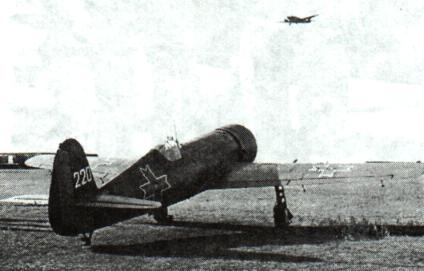
Picture from "Vanatorul IAR-80, istoria unui erou necunoscut" by
Dan Antoniu & George Cicos, MODELISM, 2000
| Wingspan |
11 m |
| Length |
8.97 m |
| Height |
3.525 m |
| Weight (empty) |
2135 kg |
| Weight (loaded) |
2810 kg |
| Maximum speed at 5000 m |
485 km/h |
| Climbs to 5000 m |
6 min. 30 sec. |
| Maximum operational ceiling |
10000 m |
| Range |
730 km;
1030 km (with extra fuel tanks)
|
| Engine |
IAR 14K IVc32 1000A1 1000 HP |
| Machine-guns |
4x7.92 mm; 2x13.2 mm |
| Serial numbers |
181-200; 201-230 |
The IAR-80C
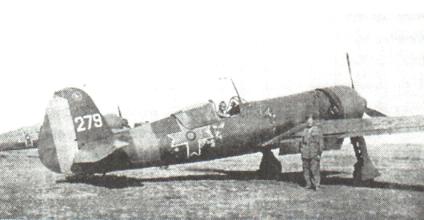
Picture from "Vanatorul IAR-80, istoria unui erou necunoscut" by
Dan Antoniu & George Cicos, MODELISM, 2000
| Wingspan |
11 m |
| Length |
8.97 m |
| Height |
3.535 m |
| Weight (empty) |
2200 kg |
| Weight (loaded) |
2880 kg |
| Maximum speed at 5000 m |
485 km/h |
| Climbs to 5000 m |
7 min. |
| Maximum operational ceiling |
10000 m |
| Range |
730 km;
1330 km (with extra fuel tanks)
|
| Engine |
IAR 14K IVc32 1000A1 1000 HP |
| Machine-guns |
4x7.92 mm |
| Guns |
2x20 mm |
| Serial numbers |
241-290 |
The IAR-81
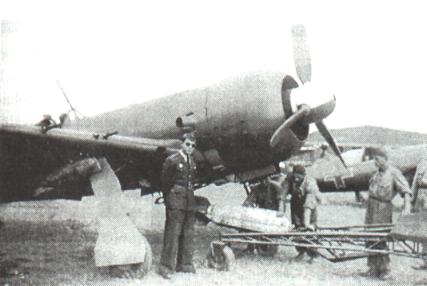
Picture from "Vanatorul IAR-80, istoria unui erou necunoscut" by
Dan Antoniu & George Cicos, MODELISM, 2000
| Wingspan |
10.52 m |
| Length |
8.97 m |
| Height |
3.525 m |
| Weight (empty) |
2200 kg |
| Weight (loaded) |
3125 kg |
| Maximum speed at 5000 m |
465 km/h(bomber);
485 km/h(fighter)
|
| Climbs to 5000 m |
7 min. 30 sec.(bomber);
6 min. 30 sec.(fighter)
|
| Maximum operational ceiling |
10000 m |
| Range |
695 km(bomber);
730 km(fighter);
1330 km (with extra fuel tanks)
|
| Engine |
IAR 14K IVc32 1000A1 1000 HP |
| Machine-guns |
6x7.92 mm |
| Bombs |
1x250 kg; 2x50 kg |
| Serial numbers |
241-290 |
The IAR-81A
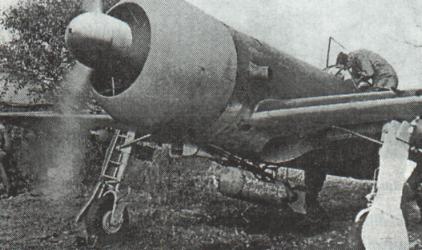
Picture from "Vanatorul IAR-80, istoria unui erou necunoscut" by
Dan Antoniu & George Cicos, MODELISM, 2000
| Wingspan |
11 m |
| Length |
8.97 m |
| Height |
3.525 m |
| Weight (empty) |
2190 kg |
| Weight (loaded) |
3190 kg |
| Maximum speed at 5000 m |
465 km/h(bomber);
485 km/h(fighter)
|
| Climbs to 5000 m |
7 min. 30 sec.(bomber);
6 min. 30 sec.(fighter)
|
| Maximum operational ceiling |
10000 m |
| Range |
695 km(bomber);
730 km(fighter);
1330 km (with extra fuel tanks)
|
| Engine |
IAR 14K IVc32 1000A1 1000 HP |
| Machine-guns |
4x7.92 mm; 2x13.2 mm |
| Bombs |
1x250 kg; 2x50 kg |
| Serial numbers |
291-300 |
The IAR-81C
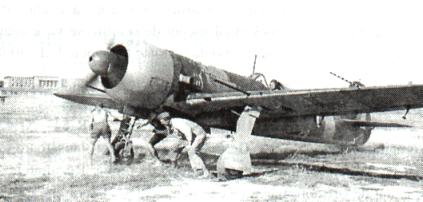
Picture from "Vanatorul IAR-80, istoria unui erou necunoscut" by
Dan Antoniu & George Cicos, MODELISM, 2000
| Wingspan |
11 m |
| Length |
8.97 m |
| Height |
3.535 m |
| Weight (empty) |
2200 kg |
| Weight (loaded) |
2900 kg |
| Maximum speed at 5000 m |
485 km/h |
| Climbs to 5000 m |
7 min. |
| Maximum operational ceiling |
10000 m |
| Range |
730 km;
1330 km (with extra fuel tanks)
|
| Engine |
IAR 14K IVc32 1000A1 1000 HP |
| Machine-guns |
4x7.92 mm |
| Guns |
2x20 mm |
| Serial numbers |
301-450 |
|